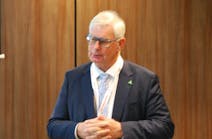Making the case for ammonia as sustainable ‘liquid electricity’
It’s not easy to capture lightning in that now-famous bottle, but it could be much easier if ammonia serves as a chemical bottle of sorts.
The holy grail of sustainability is how to preserve inherently transitory electricity generated by wind, solar and other alternative energy sources. Numerous methods and technologies have been explored, such as flywheels, molten salt, superconductivity, stored hydropower and others, and some preferable options will no doubt emerge when they can prove they’re more efficient than their competitors.
But one of the most promising candidates today is ammonia along with increasingly green techniques for manufacturing it, including several accompanied or enabled by hydrogen production.
“Ammonia has been mentioned for years as a possible energy carrier, and it’s emerging as a way to preserve power produced by wind and solar farms that would otherwise be idle after meeting the present needs of their local grids,” said Hans Vrijenhoef, president of Proton Ventures and past president of the 200-member Ammonia Energy Association in a Honeywell Users Group EMEA session this week exploring ammonia’s potential. “When people see wind turbines aren’t turning even though the wind is blowing, they start to ask about using that curtailed energy to make ammonia from hydrogen.”
Proton in profile
Staffed by 40 engineers, Vrijenhoef reports that Proton Ventures is a 24-year-old designer and developer of hydrogen and ammonia facilities including modular production units, terminals for storage and handling, nitrous oxide removal systems, and partners in developing Battolyser technology, which combines the functions of a battery and an electrolyzer in one device to store and supply electricity and produce hydrogen.
“The Arenha pilot develops advanced materials and designs and include Proton’s advanced ammonia synthesis unit that can produce 10 cubic meters per hour,” explained Vrijenhoef. “We want to produce along the entire ammonia supply chain, which includes power-to-ammonia, ammonia-to-hydrogen, and hydrogen-back-to-power applications.”
Pros of power via molecule
“Even though hydrogen production is 100 years old, well-understood and proven-at-scale technology, we believe it’s the oil of the future, and is equivalent to liquid electricity,” Vrijenhoef said. “Delivering power via a molecule instead of a cable gives wind and solar the lowest cost electricity at less than 2 cents per kWh. This is cheaper than natural gas, and makes renewables much more attractive,” said Vrijenhoef.
“This is why we need partners like Honeywell to help us gain its capabilities and advantages. For example, it’s flexible because it can be produced anywhere worldwide, and transported using existing terminals and logistics. It’s also easy to grow because there’s enough molecular nitrogen in the air for production versus carbon dioxide in the air for making methanol.”
Despite its many advantages, Vrijenhoef acknowledged that ammonia’s main drawback is that building its production processes and support infrastructures require CapEx that are more costly than natural gas and other energy sources. “Ammonia does require greater initial upfront investment, but it’s more worthwhile than ever because it’s demonstrating even more new benefits,” added Vrijenhoef. “Because it can be made anywhere, ammonia frees its producers and consumers from geopolitics because they can easily produce and maintain their own reserves.”
Vrijenhoef reported about 200 million tonnes of ammonia are presently produced worldwide, and 80% is used for fertilizer. However, new uses for it such as turbines and furnaces are multiplying quickly, and this will quickly expand its markets. In fact, Vrijenhoef estimated that Europe could accomplish its entire transition to renewables by producing 1 billion tonnes of ammonia per year, while the world could do the same by producing about 3 billion tonnes per year.
Most notably, Mitsubishi’s new gas turbines, MAN Energy Solutions’ two-stoke marine engines, and Wartsila’s four-stoke barge engines are fueled by ammonia, but have only 1-3 parts per million (ppm) emissions of nitrogen oxide or sulfur oxide, while they also produce zero ppm of carbon dioxide. Many of these engines are already being deployed on freighters, automotive carriers, barges and other ammonia-ready vessels.
Honeywell on hydrogen, ammonia partnership
John Colpo, strategy and marketing lead for LNG and midstream at Honeywell Process Solutions, added that, “Honeywell recognizes the role of low-carbon ammonia as a key enabler in the energy transition and remains committed to its early commitments to achieving carbon neutrality. Ammonia is a versatile molecule that combusts without producing greenhouse gases, as well as being easily cracked to recover hydrogen.”
Because hydrogen is a “difficult” molecule, Colpo explained it’s generally consumed at the place of production. However, alternatives now exist to assist in hydrogen logistics, and the coming trend is that hydrogen is likely to be:
- Produced at the termination point of supply chain;
- Converted to ammonia, methanol or a liquid, organic hydrogen carrier (LOHC) at the same terminal;
- Loaded onto specialized ships for transport; and/or
- Cracked in part or entirely to recover hydrogen molecules for various applications, such as injection or blending into natural gas-fueled grids.
“Accordingly, low-carbon ammonia terminals will be significantly more complex compared to existing ammonia terminals, and specialized EPCs, OEMs and automation providers such as Proton Ventures and the various Honeywell units are top examples of end-to-end partners that can simultaneously optimize throughput and derisk CapEx and operating expenditure OpEx activities,” explained Colpo.
“Honeywell provides a full portfolio of process design, process equipment, special consumables and EPC packages, including the most recent editions of Sundyne’s compressors and pumps, which meet demanding conditions in ammonia and hydrogen production and handling,” Colpo said. Likewise, Honeywell UOP is aiming to soon complete its acquisition of Johnson Matthey, which offers process designs and improved catalysts for ammonia production and cracking. For example, the company’s Katalco 74-1 Green solution enables green ammonia synthesis with reduced energy consumption and operating costs.”
“I think most people now accept that the Paris Climate Agreement’s recommendations can make the world a better place,” concluded Vrijenhoef. “So, the ammonia economy is coming, but it’s just going to need some preparation.”

